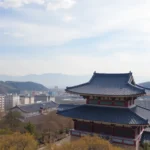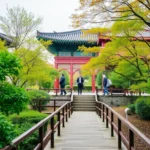10 top things to see and do in Gyeongju

Imagine walking through a city where every corner tells a story, where ancient tombs rise gently from the earth, and where the architecture whispers the glories of a bygone era. Welcome to Gyeongju, the former capital of the Silla Dynasty, a time that shaped much of Korea's rich cultural heritage. If you're eager to uncover the hidden gems and must-see sights in this historic city, you're in the right place!
During our two-day adventure in Gyeongju, we found ourselves enchanted by its treasures, from majestic tombs to serene palaces. It quickly became one of the highlights of our journey through South Korea, leaving us with unforgettable memories and a thirst for más historia. Let's dive into the top experiences this city has to offer!
Exploring the must-see sites in Gyeongju
Gyeongju is often referred to as the "museum without walls," a testament to its rich historical significance. As you wander through its streets, you’ll encounter remnants of the Silla Dynasty at every turn. If you are wondering about Gyeongju what to see, here’s a curated list of the places you simply cannot miss:
1. Tumuli Park (Daereungwon Tomb Complex)
Step into the serene landscape of Tumuli Park, where ancient royal tombs, known as tumulus, lay nestled among the grassy knolls. This park houses around 20 tombs, with the Cheonmachong tomb being the most notable. Here, you can explore the interior, which has been reconstructed to showcase the burial practices of the Silla elite.
The name Cheonmachong translates to "heavenly horse tomb," inspired by a horse drawing found in the wooden coffin. As you enter, you might feel like a modern-day archaeologist discovering a piece of history.
- Entry fee: 3,000₩
2. Bonghwangdae Complex
Located just in front of Tumuli Park, the Bonghwangdae tomb is the largest in Gyeongju, standing at 22 meters high. While you’re here, stop by Coffee Place for an excellent coffee experience. Next door, the Geumgwanchong tomb features a fascinating exhibition on the construction of these ancient burial sites, further enriching your understanding of Gyeongju's history.
Remember, climbing on the tumuli is strictly prohibited to preserve their sanctity, and violations may lead to hefty fines.
3. Donggung Palace and Anapji Pond
Another highlight of Gyeongju is the Palace of Donggung, built in 679 AD as a royal residence for the Silla Dynasty's crown prince. This exquisite palace is set around the picturesque Anapji Pond (also known as Wolji), where the reflection of the buildings creates a perfect photo opportunity.
Visiting during the "golden hour" just before sunset is highly recommended, as the sky transforms into a breathtaking palette of colors. If you arrive during the day, don’t worry; the beauty of the palace remains captivating!
- Entry fee: 3,000₩
4. Woljeonggyo Bridge
For those who appreciate stunning architecture, Woljeonggyo Bridge is a must-visit. This impressive structure, a replica of the original built around 760 AD, spans the Namcheon Stream. Its grandeur often leads visitors to describe it as the most beautiful bridge in Korea.
As you stroll across, take in the tranquil waters of the river and the traditional Hanok village in the distance. The atmosphere here is simply magical.
5. Gyeongju National Museum
The Gyeongju National Museum showcases the rich history of the Silla Dynasty through a remarkable collection of artifacts, including golden crowns from the 5th century that evoke the opulence of the era. You’ll find the famous crown recovered from Cheonmachong and the stunning Hwangnamdaechong crown, which is often highlighted as a national treasure.
Don’t miss the Great Bell of King Seokdeok the Great, located in the museum's garden, renowned for its impressive sound. The museum is free to enter and is a fantastic way to delve deeper into Gyeongju's past.
6. Cheomsongdae Observatory
Gyeongju is home to Cheomsongdae, recognized as one of the oldest observatories in Asia, possibly the oldest of all. This simple stone tower, approximately 1,300 years old, offers a glimpse into the astronomical practices of ancient Korea.
With 12 stones at the base representing each month and 30 stones above symbolizing days, the total of 366 stones signifies a complete year. Entrance is free, and for families, a small electric train ride through the surrounding gardens costs 4,000₩ for adults.
7. Hwangnidan-gil Street
For a taste of Gyeongju's contemporary culture, head to Hwangnidan-gil Street, a vibrant area filled with charming Hanok buildings transformed into trendy cafes, shops, and restaurants. Here, you must try the local dessert shaped like a 10₩ coin, a cheesy waffle that’s simply delightful!
This lively street is also a great spot for a fun photobooth session and offers a plethora of dining options, with varied prices to suit all budgets. Just remember that many restaurants close between 3 PM and 5 PM.
8. Gyochon Traditional Village
Crossing the Woljeonggyo Bridge leads you to the peaceful Gyochon Traditional Village, a much quieter alternative to the bustling Bukchon in Seoul. Here, you can visit the Choi Clan House, enjoy tea in a traditional teahouse, or wander through the quaint streets dressed in a hanbok, the traditional Korean attire.
While there are restaurants serving authentic Korean dishes, be prepared for slightly higher prices in this picturesque setting.
9. Nodong Dong District
Just north of the city center and a short walk from Tumuli Park lies the vibrant Nodong Dong district. This bustling area is filled with shops, cafes, and fast-food options, making it a great place to unwind after a day of exploring.
It’s also a popular area for dining, offering a wide selection from Korean BBQ to Japanese cuisine. Keep in mind that many places serve dinner only until around 8 PM, so plan accordingly!
10. Bulguksa Temple
No visit to Gyeongju is complete without a trip to the magnificent Bulguksa Temple, built during the reign of Gyeongdeok in 751 AD. Aunque gran parte fue destruida durante las invasiones japonesas, ha sido fielmente reconstruida y reconocida como Patrimonio de la Humanidad por la UNESCO.
To reach the temple from Gyeongju, take bus numbers 10, 11, or 700, which will get you there in about 30 minutes. The entry fee is 6,000₩.
11. Seokguram Grotto
Visiting Bulguksa will also allow you to see the Seokguram Grotto, an important site for Buddhist pilgrims. Inside, you’ll find a nearly four-meter-tall statue of Buddha, acclaimed for its beauty and serenity. However, photography is not permitted inside.
To get to the grotto from the temple, you can take bus number 12 or enjoy a scenic three-kilometer hike—though be aware that the trail was closed during our visit due to landslides.
- Entry fee: 6,000₩ (no combined ticket available)
Additional things to see and do in Gyeongju and nearby
The aforementioned experiences are just the tip of the iceberg when it comes to exploring Gyeongju. If you have extra time and energy, consider adding these activities to your itinerary:
- Visit Yangdong Village, a traditional village from the Joseon Dynasty, a UNESCO World Heritage site. It’s about a 40-60 minute bus ride from Gyeongju.
- Families traveling with kids might enjoy a fun day at Gyeongju World, an amusement park filled with thrilling rides.
- Experience a templestay at Golgusa Temple, which offers a unique insight into monastic life.
- Don’t leave without trying the Hwangnam bread, a popular local delicacy that features a sweet red bean paste filling.
- For a unique coffee experience, visit one of the world’s prettiest Starbucks located at 125 Cheomseong-ro.
- Explore the Seongdong Market for a glimpse into daily life in Gyeongju, perfect for capturing authentic local scenes with your camera.
Planning your visit to Gyeongju
To make the most of your trip to Gyeongju, here are some practical tips for your itinerary:
How to get to Gyeongju
The Gyeongju train station is currently closed, so if you plan to travel by train, head to the nearby Singyeongju Station, which connects to major cities like Busan (approximately 11,000₩, 35 minutes).
Another option is to take an express or intercity bus from Daegu, costing around 9,000₩ and taking about 1 hour and 10 minutes. Both bus stations are conveniently located west of the city.
For a comprehensive experience, consider a day tour from Busan that includes stops at Yangdong Village and Bulguksa Temple. You can book this tour here.
Where to stay in Gyeongju
During our visit, we stayed at Mini Hotel 141, where we paid €42 per night. Despite its name, it was quite spacious and comfortable, located about a 10-minute walk from the city center.
Where to eat in Gyeongju
We had a fantastic culinary experience in Gyeongju. To help you discover the local food scene, we've prepared a guide with five recommended restaurants (coming soon).
How to get around Gyeongju
We found walking to be the best way to explore Gyeongju. However, consider renting a bicycle for a more efficient way to cover ground, as the city is relatively flat and bike-friendly. There are also electric trikes available for rent, though they can be pricier at around 30,000₩ per hour. Additionally, the Gyeongju City Tour bus offers five different routes throughout the city and surrounding areas.
Map of Gyeongju
We’ve incluido un mapa destacando todas las ubicaciones clave para visitar en Gyeongju y las atracciones cercanas:
As you plan your trip to South Korea, remember to include Gyeongju in your itinerary. This city is a treasure trove of history and beauty, and remember to wear comfortable shoes—your feet will thank you after all the walking! If you're still considering what to see in Gyeongju, there’s no shortage of attractions that will captivate you.
Stay updated on our travels in South Korea by following our Instagram stories.
| Save on your trip |
| Compare and find cheap flights here |
| Find accommodation at the best prices here |
| Book activities and excursions in Spanish here |
| Get a 5% discount on your travel insurance with IATI here |
| Book airport transfers here |
| Find out how to withdraw money without commissions here |
| Rent a car with the best deals here |
| Discover the best books and travel guides here |
| Explore all our articles about South Korea |





Deja una respuesta